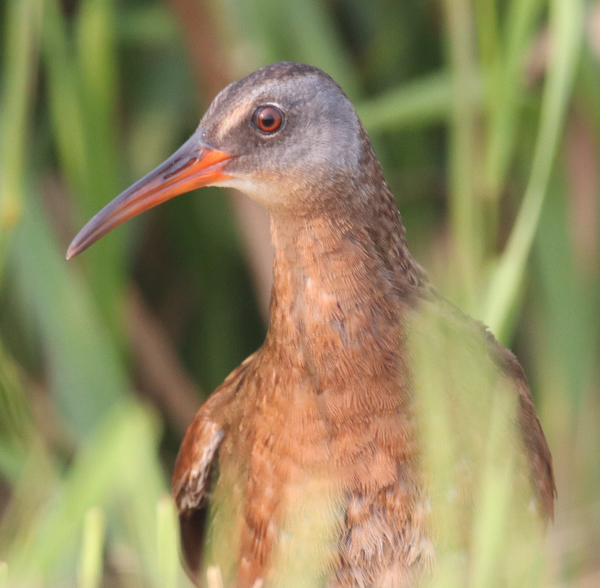
Tipped off when 2 downy black hatchlings walked into the open, an adult Virginia Rail provided Paul’s first photographs of this secretive species.
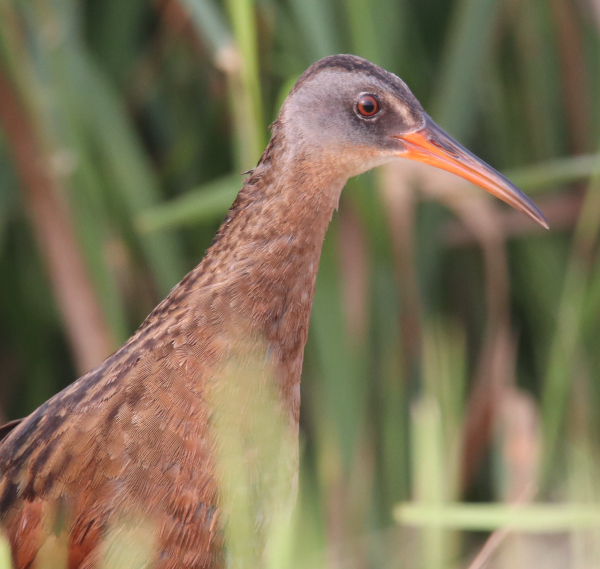
Still partly hidden behind marsh vegetation, the elusive Virginia Rail continued to preen and stretch before melting into the background curtain of plants.
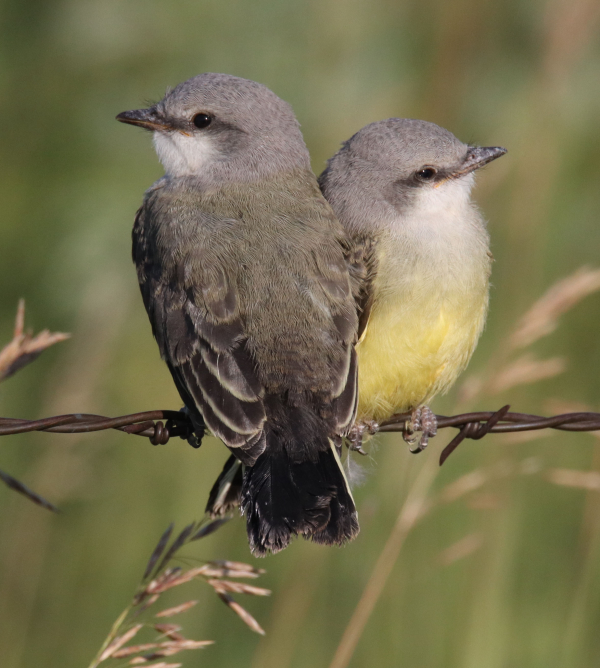
Fresh from the nest, these Western Kingbird fledglings provided some interesting observations and photographs. Note the short, still-growing tail and wing feathers; and how the kingbird fledglings continued to keep in close contact, similar to when they were in the nest together.
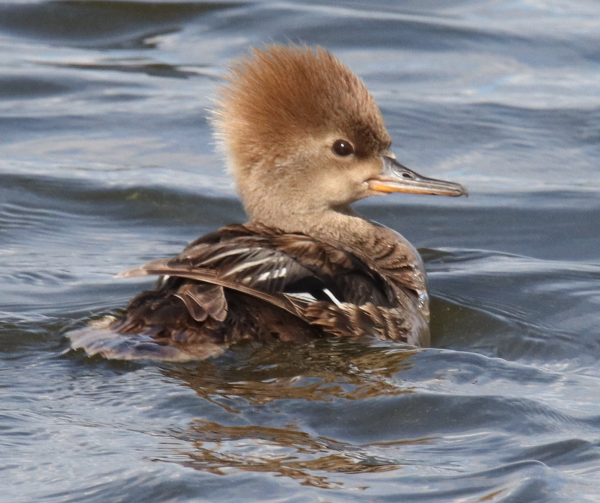
A female Hooded Merganser held her crest erect for this photograph that also shows the thin sharp bill typical of fish-eating mergansers. You can see a photo of another female with her crest relaxed that is followed by a brood of downy young merganser ducklings in the Bird Photography feature.
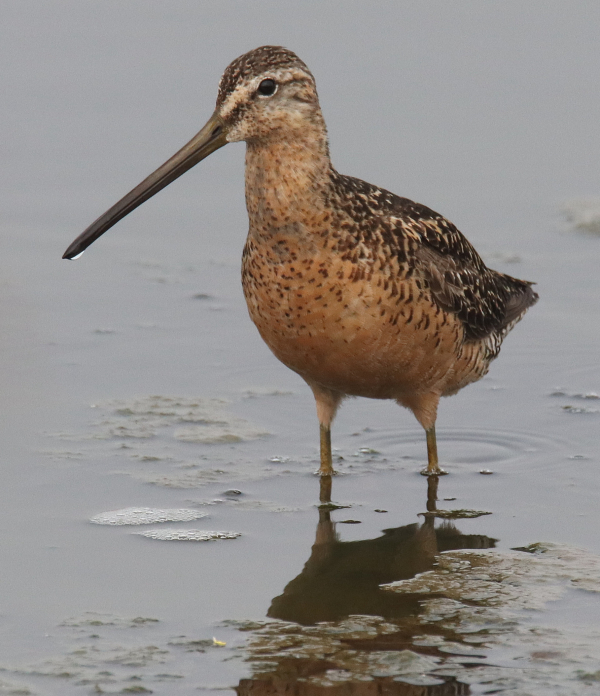
The influx of Arctic-nesting shorebirds returning to feed and molt in the Northern Great Plains is represented by a close photo of a Long-billed Dowitcher, still in its rufous and brown breeding plumage.
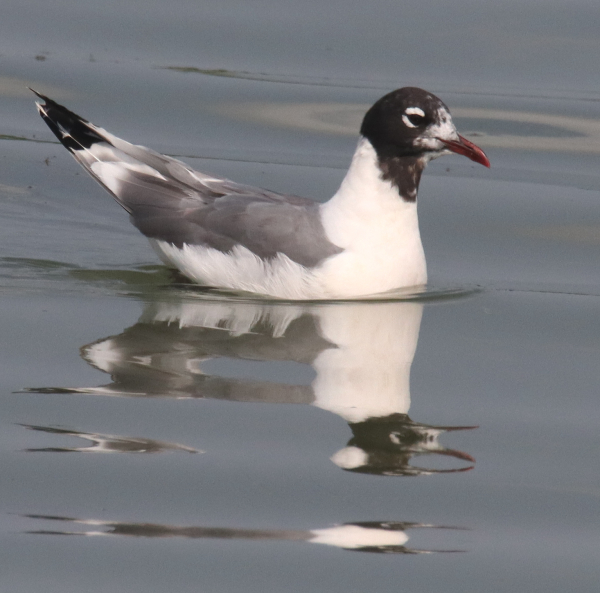
The return of Franklin’s Gulls to area marshes provided the opportunity to document fledgling and yearling plumages as well as to show the initiation of molting in this adult’s face.
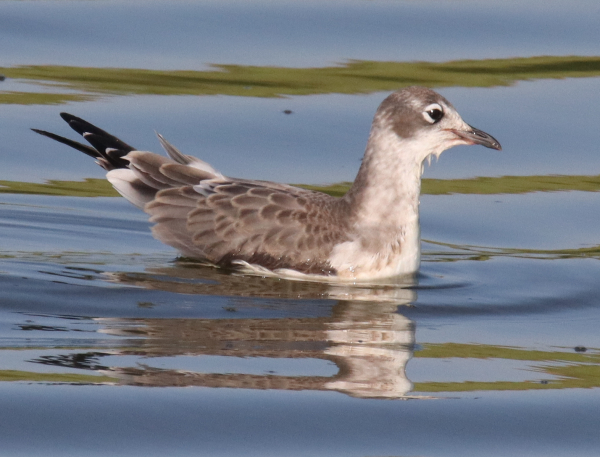
This recently fledged gull would be harder to identify if it wasn’t in the company of other Franklin’s Gulls foraging in a loose flock. The region is alive with new fledglings that are bolstering populations of birds as the nesting season is winding down.
|
New fledglings and hatchlings continue to dominate the excitement of mid-summer, with new fledglings including Western Kingbirds, more Eastern Kingbirds, and new hatchlings that included Virginia Rails, Red-necked Grebes, Wild Turkeys, Hooded Mergansers, and Ruddy Ducks with a variety of new duck broods appearing every day. At the same time, there is an obvious initial influx of shorebirds that are arriving – some species by the hundreds, including Long-billed Dowitchers, Stilt Sandpipers, and Wilson’s Phalaropes with lesser numbers of yellowlegs and other sandpipers.
Locally, the abundance and diversity of birds is impressive and fuels more birding drives south of my office where a variety of wetlands and large native prairie areas are prevalent. The first unexpected sighting of the week was an adult Red-necked Grebe with 3 large fledgling-aged young swimming just 2 miles south of home, in a marsh where I haven’t seen a Red-neck (at least not a bird) in that area this season (that wetland is more than a half-mile long with a couple curves, so it’s only possible to see a small segment of it from the most accessible point). Conversely, I haven’t seen a Red-necked Grebe for weeks where they’ve been most commonly encountered this year, at Herb’s Lake and associated marsh.
The other surprise brood sighting was 6 Hooded Merganser ducklings aged about 10 or 12 days old, observed with the adult female the following day 2 miles southwest of the grebes. The Hoodies and the first Ruddy Duck brood of the season were part of a mega brood count of 26 duck broods last Wednesday, composed of 11 different species! It takes a windless or almost windless day to make such a comprehensive count, but last Wednesday was just such a day when broods feed in the open water of shallow marshes and lake edges. In addition to the many duck broods, I also spied a brood of 7 large fully-feathered pheasants with the adult female.
Headed for home that evening, as I topped a little hill an adult Bald Eagle was alerted as it stood at the side of a familiar marsh. It spread its wings high above its back to take flight, but my secondary point of interest was the pile of feathers left behind on the edge of the wetland. With the eagle perched on a boulder on the opposite side of the marsh, I passed by the remains, expecting the prey to be a duck, so I was surprised to see remnants of a cormorant.
During the week, in a few grassland areas a number of Orchard Orioles were especially active, and I was able to count more than 10 individuals at one location where they were actively searching for insects among tall vegetation. There were also Clay-colored Sparrows, Bobolinks, and many Western Kingbirds and Eastern Kings. It was noticeable that Western Kingbirds must have initiated nesting the same couple days a month before – about June 20th – because each evening I encountered a few broods of Western fledglings, composed of 2 or 3 really cute little guys, often perched shoulder to shoulder, fresh out of the nest where they were in similarly close proximity before.
During a birding drive to the north, a huge shallow rainwater basin that I mentioned last week that had an estimated 100-plus Long-billed Dowitchers, now contained hundreds more dowitchers on Friday, closer to 300, along with more than 100 Stilt Sandpipers, about 60 Greater and Lesser Yellowlegs, 200 Wilson’s Phalaropes, and a few Pectoral Sandpipers, White-winged Sandpipers, Killdeer, and Wilson’s Snipe.
That’s a lot of shorebirds concentrating after migrations south from Arctic and boreal forest nesting ranges, plus the grassland-nesting phalaropes. But there was also an extension of the shallows to the east where I could not identify the species, but could see there were hundreds more sandpipers. The wetland was noticeably shallower than when I viewed it 4 days earlier, with hundreds more shorebirds on hand; now, as the water level becomes shallower this could be an especially interesting staging area for returning shorebirds as the water draws down.
Toward Bismarck
It had been almost a month since I last drove west to Bismarck, so Wednesday I was back on track, checking my birding hotspots along the way. The first stops were the 2 Ferruginous Hawk nests, which revealed similar results: At the south nest, all 3 fledglings were standing on the nest; and at the north Ferrug nest, the 4 fledglings were all perched within 4 feet of the nest, essentially standing a foot apart on the same branch. There was no sign of adults in the area of either nest, but the positioning of the fledglings was an indicator that the adults were still using the nests as food drop-off points for fledglings as the young hawks learn to hunt during the post-fledging period.
There were scattered raptors along the way to Long Lake National Wildlife Refuge: Swainson’s Hawks, Red-tailed Hawks, and a few Northern Harriers. As I turned into the location where I previously photographed Western Grebes with hatchlings, I wasn’t sure what to expect, but as the stream opening came into view the open water was covered with grebes. Most were half-grown young – about 20 – with about half that number of adults, plus a few White Pelicans. The waterway was crowded, and the grebes were vocal, especially the young grebes that were loudly begging for food. There were even 2 late-hatched broods of downy young grebes still riding the back of adults, making for quite a spread of time between the first eggs laid and the last eggs hatched among the greater population there.
A huge concentration of Bank Swallows was assembled near the refuge headquarters, which is the norm at this time of the summer, and there was a mix of Franklin’s Gulls, Black Terns, and Ring-billed Gulls, including recently fledged young of the year with most adults beginning to molt. I did note a scarcity of ducks in and around the refuge this time, although it’s an expansive refuge.
Closer to Bismarck, as the evening progressed and the water calmed at Dogtown Marsh, the duck broods were literally coming out of the weeds – well, out of the cattails: 1 brood of Wood Ducks, 2 broods of Blue-winged Teal, 3 broods of Mallards, 3 broods of Northern Shovelers, and 3 Redhead broods, all with attendant females. There was also a brood of 6 downy Pied-billed Grebes with a female.
Southside Excitement
Surrounded by exciting bird observations during a Saturday evening birding drive south of my office, I was observing a brood of 2 week old Lesser Scaup ducklings diving for food with the adult female when my attention was diverted to the road ahead. Two small dark birds were moving cautiously onto the road – 2 small black downy rails that in a moment ran across the gravel road! That’s a first for me I thought, expecting they were Virginia Rails; birds that are so secretive that it’s extremely rare see one in this region. Last year I saw an adult as it flew across a roadway not far from this location, but I can’t remember the last time I’ve seen one before that. This sighting was merely a quick look at 2 tiny rails, zoom, and then they were hidden among thick marsh vegetation again.
I gingerly eased my mobile blind forward (my car), hoping to intercept another downy black hatchling, or an adult. A moment later, darned if there wasn’t an adult rail preening and stretching on the edge of the wetland vegetation near the road, at about the same location where the hatchlings originated. I tried to find an opening in the grass where I could get a fairly clear photo of this rarely seen but fairly common species – it would be my first photo of a Virginia Rail.
I was pleasantly surprised that the rail did not flinch at my fairly close approach – I didn’t want to get that close due to my concern about impacting the elusive bird in some way, but the plants that shielded the rail opened just a bit, enough to hope for a photo. The adult rail was obliging as it continued to preen a bit and turned from side to side. What luck! I thought Virginia might walk into the open to cross the road too, but it ducked behind some cattails, and after waiting a minute to see if it would re-appear, I continued on my way.
My next stop was Charo Marsh, which has been unusually quiet lately, but with shorebirds migrating south now I expected a few would eventually find the little bay that sandpipers and plovers find so attractive. A Lesser Yellowlegs and a couple Killdeer were all that I could see initially, but when I scanned the shoreline with binoculars, there were a number of sandpipers “hidden” on shore. A tight flock of 9 Greater Yellowlegs was preening and resting, some lying on the ground; and there were 2 Lesser Yellowlegs, a Pectoral Sandpiper, a Spotted Sandpiper, and 1 Wilson’s Phalarope – until 4 more phalaropes flew in, all in basic plumage. There were also a number of Orchard Orioles active on the prairie adjacent to Charo, at least 2 adult males and a fledgling – and a pair of Bobolinks.
Returning to Charo late Monday, there were 7 Pectoral Sandpipers, a like number of Killdeer, a Lesser Yellowlegs, and a lone Long-billed Dowitcher probing the mud beneath shallow water, still in its rufous breeding plumage. I managed a few nice photos of the dowitcher in action. In one photo I could see it was pulling up a worm that looked most like an earthworm. There were also 3 obvious duck broods on Charo Marsh, along with another half-dozen along the way – some so small they must have hatched that morning.
I’m excited about birding during the week ahead, and hope you get into the field as often as possible, whether it’s down the street to a local park, or down the road at a nearby wetland or tree grove. It’s an exciting period, and the more habitats you visit, the more likely you are to find different birds. Any time you have your binoculars or camera or both in hand, life gets a little more exciting – Good Luck!
Article and Photos by Paul Konrad
Share your bird sightings and photographs at editorstbw2@gmail.com